Botanical soaps last through cold process due to proper curing (4-6 weeks), which allows water evaporation and chemical integration. You'll get longer-lasting bars by using natural preservatives like patchouli or cedarwood essential oils, maintaining proper pH (9-11), and adding antioxidants such as rosemary extract. Superfatting at 5-10% enhances stability while creating a more nourishing product. Managing water content and selecting appropriate plant materials guarantees your handcrafted soaps maintain their quality for months to come.
What Makes Botanical Soaps Last Through Cold Process?
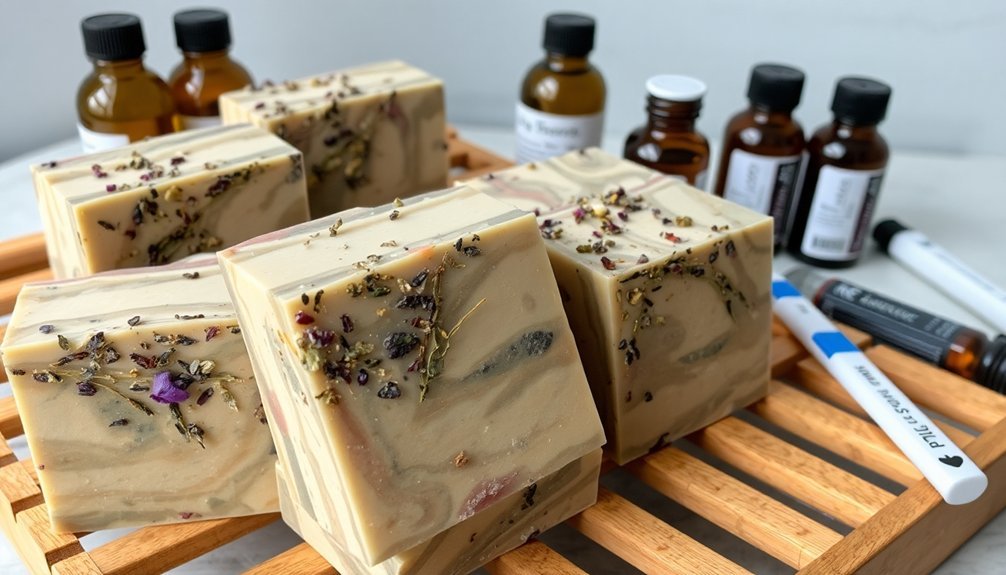
While many handmade soaps deteriorate quickly with use, botanical soaps crafted through the cold process method offer remarkable longevity. The secret lies in the curing phase, where excess moisture evaporates over 4-6 weeks, creating harder bars that resist melting in your shower.
When you select high-quality oils and butters for your base, you're establishing a stable foundation that greatly extends shelf life. The gel phase during saponification isn't just for aesthetics—it enhances color stability and contributes to your soap's durability.
Don't overlook the importance of monitoring pH levels between 9-11, which prevents bacterial growth that could compromise your soap's lifespan.
When botanical additives are properly balanced at approximately 2.2% of your batch, they'll enhance your soap's appeal without weakening its structure.
The Chemistry of Saponification in Cold Process Soap
Although it appears magical to transform oils and lye into silky soap bars, saponification follows precise chemical principles. When you combine oils with sodium hydroxide, an exothermic reaction occurs without needing external heat, creating soap molecules and glycerin.
During this cold process, these soap molecules form stable structures that encapsulate your botanical additives, preserving their properties. The lye is completely consumed, making your final product safe while maintaining the integrity of your botanicals.
The 3-4 week curing period isn't just for hardening; it's crucial for completing the chemical integration of ingredients, directly affecting soap longevity.
A properly balanced oil formula guarantees the saponification process creates a durable product that protects its botanical elements for months, maximizing both utility and natural benefits.
Essential Oils and Botanical Extracts: Choosing for Longevity

With the chemical foundation of saponification established, selecting the right aromatic and herbal components becomes the next step in crafting long-lasting botanical soaps.
You'll find certain essential oils provide natural preservatives through their antimicrobial properties, effectively extending your soap's shelf life by inhibiting bacterial growth.
For maximum longevity, choose stable essential oils like patchouli, cedarwood, or vetiver, which maintain their fragrance long after lighter citrus oils have faded.
Add botanical extracts such as rosemary to act as natural antioxidants that prevent rancidity in soap fats.
Don't overlook functional botanical powders—moringa and spirulina contribute both vibrant color and durability.
Remember that proper storage in cool, dry places away from direct sunlight greatly preserves both essential oils and botanical extracts in your cold process creations.
The Role of Superfatting in Soap Stability
Beyond the basic saponification process, superfatting stands as a critical technique that dramatically enhances your botanical soap's stability and longevity.
When you add 5-10% more oils than what lye can convert during saponification, you're creating a more nourishing product that retains moisture effectively.
This super-fat level isn't just about luxury—it's practical chemistry that prevents your bars from becoming harsh or drying. The unconverted oils act as natural preservatives, extending your soap's shelf life while maintaining its gentle properties.
For botanical soaps specifically, superfatting helps preserve delicate scents and textures that might otherwise deteriorate quickly.
You'll notice your finished bars remain stable, moisturizing, and pleasant to use throughout their extended lifetime, making the extra oils a worthwhile investment in your soap's overall quality.
Natural Preservatives in Botanical Ingredients
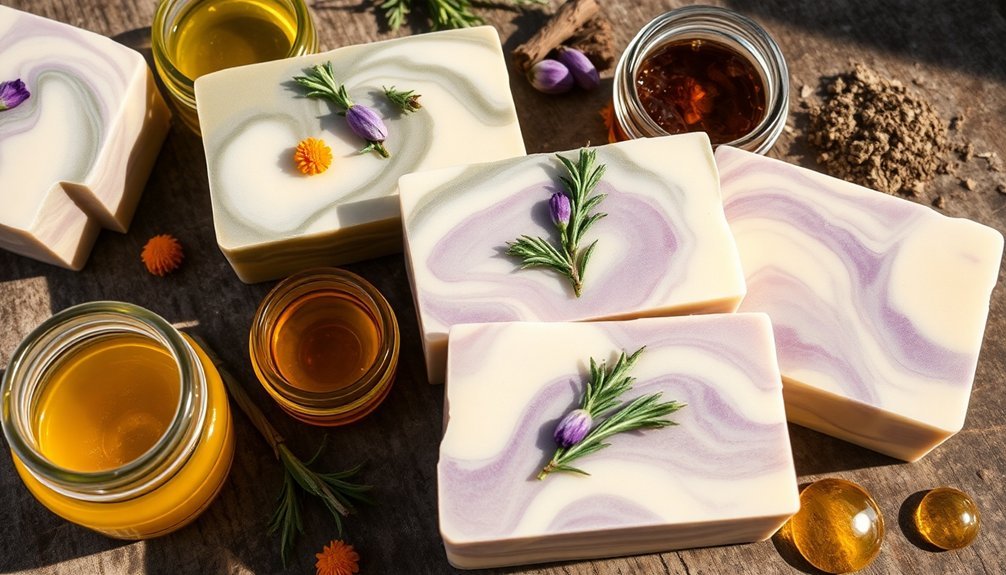
Essential oils aren't just fragrant additions to your botanical soap—they're powerful antibacterial agents that naturally extend shelf life while offering therapeutic benefits.
You'll find that citrus, tea tree, and lavender oils effectively inhibit microbial growth, protecting your handcrafted soaps without synthetic preservatives.
For maximum preservation potential, consider incorporating tannin-rich plant matter like oak bark, witch hazel, or green tea, which naturally stabilize your soap while adding skin-beneficial astringent properties.
Essential Oil Antibacterial Properties
Natural preservation in botanical soaps comes powerfully packaged in essential oils, which offer more than just delightful fragrances. Their antibacterial properties can greatly extend your soap's shelf life by disrupting bacterial cell membranes that cause spoilage.
When you incorporate oils like tea tree, lavender, and eucalyptus at 1-3% of total soap weight, you're not just adding scent—you're introducing natural preservatives. The chemical compounds in these oils, particularly terpenes and phenols, actively combat common pathogens.
Rosemary and oregano oils have shown remarkable effectiveness in this regard.
For maximum protection in your botanical soaps, consider combining different essential oils. This creates synergistic effects with broader antimicrobial coverage.
Your cold process soaps will benefit from both the aesthetic appeal and practical preservation these powerful plant extracts provide.
Tannin-Rich Plant Matter
While essential oils provide excellent antibacterial protection, tannin-rich plant matter offers another powerful preservation pathway for your botanical soaps.
These polyphenolic compounds naturally inhibit bacterial growth, extending your soap's shelf life while stabilizing color and scent profiles.
When formulating your next botanical soap, consider these tannin-rich options:
- Tea leaves (black, green, or white) – include at 3-5% of total botanical ingredients
- Witch hazel extract – provides both preservation benefits and anti-inflammatory properties
- Certain fruits like pomegranate or blackberries – add natural color while contributing preservative qualities
For maximum effectiveness, incorporate these botanical ingredients at 2-5% of your total formula.
You'll not only enhance longevity but also add valuable skin benefits to your soap formulation, creating products that remain stable and effective considerably longer than those without tannin support.
Proper Curing Techniques for Maximum Shelf Life
Once you've poured your botanical soap into molds, the essential curing process begins—a phase that determines your product's longevity and quality. Proper curing takes 4-6 weeks, allowing moisture evaporation that transforms your soft creation into a hard, long-lasting bar.
Store your soap in a cool, dry place with good air circulation to prevent humidity-related issues like mold. Turn bars occasionally to guarantee even drying throughout the curing period.
Keep them away from direct sunlight and temperature fluctuations that can compromise their integrity.
Don't skip checking pH levels of your cured soap—they should remain between 9-11 for safety and quality. This attention to detail during curing not only extends shelf life but also preserves the botanical properties you've carefully incorporated into your handcrafted bars.
Water Content Management in Botanical Soap Formulations
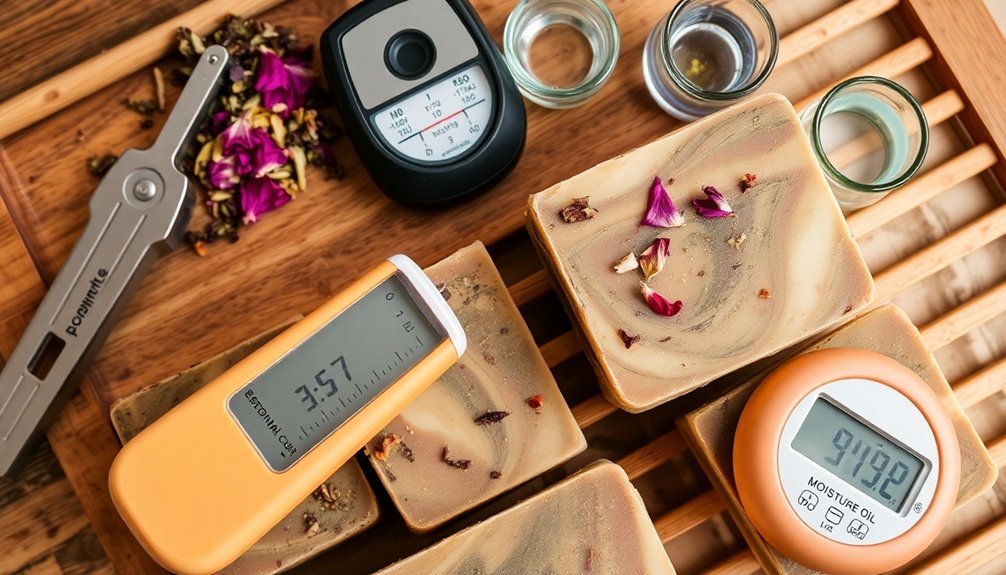
Achieving the perfect balance of water in your botanical soap formulations directly impacts both quality and longevity of the final product.
When you're working with juicy ingredients like fresh vegetables or high-moisture botanicals, you'll need to manage water content carefully to prevent creating a soft soap that won't cure properly.
To maintain an ideal oils ratio and create a firm soap that lasts:
- Strain juiced vegetables thoroughly to remove excess moisture before adding them to your soap mixture.
- Limit botanical additions to approximately 1 teaspoon of puree or juice per pound of fats.
- Balance your water-to-oil ratio carefully, reducing water elsewhere in your formula if you're adding moisture-rich ingredients.
Proper water management guarantees your botanical soaps will maintain their structure, effectiveness, and shelf life throughout the curing process.
Ph Balancing for Optimal Botanical Performance
When crafting botanical soaps, you'll need to maintain a pH between 9-11 to guarantee your plant ingredients remain effective and don't degrade prematurely.
You can use pH testers or strips after curing to confirm your soap reaches this ideal range, which also prevents harmful bacteria and mold growth.
Consider how your botanical additives naturally affect pH balance, and adjust formulations with ingredients like sodium lactate to optimize both the performance and longevity of your natural soap components.
Ideal Ph Ranges
The perfect balance between gentleness and effectiveness in botanical soaps hinges on maintaining a suitable pH level between 9 and 11.
This specific range guarantees your botanical ingredients retain their beneficial properties while preventing degradation or color changes that occur in overly acidic or alkaline environments.
Throughout the soap-making process, you'll want to:
- Test pH levels regularly during the curing process to monitor and maintain ideal conditions
- Consider adding sodium lactate to achieve balanced pH while simultaneously improving texture and firmness
- Allow for proper curing time, typically 4-6 weeks, which naturally helps stabilize pH levels
Botanical Preservation Factors
Successful preservation of botanical properties in your soaps depends largely on maintaining precise pH balance throughout the formulation process. Aim for a pH between 9-11 during saponification to protect your botanical ingredients. Using high-quality oils that remain pH-neutral will greatly enhance the performance and longevity of your natural additives.
| Botanical Type | Ideal pH | Recommended Cure Time |
|---|---|---|
| Leafy herbs | 9.5-10 | 4 weeks |
| Flower petals | 9-9.5 | 5 weeks |
| Roots/barks | 10-10.5 | 6 weeks |
| Essential oil blend | 9-10 | 4-6 weeks |
Test different pH levels with your specific botanicals and document results. Remember that proper cure time (4-6 weeks) allows complete saponification, stabilizing pH and ensuring your botanical ingredients maintain their beneficial properties and aromatic qualities.
Anti-Oxidants and Their Effect on Soap Longevity
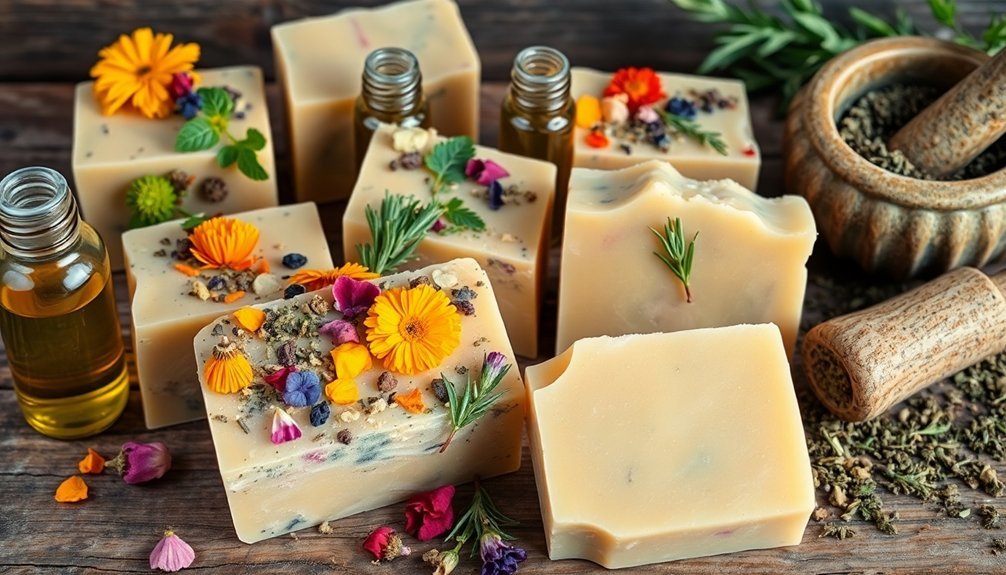
Though often overlooked by novice soap makers, antioxidants play an essential role in extending the shelf life of botanical soaps. When you incorporate antioxidant-rich ingredients into your cold process recipes, you'll notice considerably reduced rancidity and oxidation of your botanical oils.
The natural antioxidants found in high-quality botanicals actively work to:
- Stabilize the fatty acids in your soap, preventing them from breaking down over time.
- Preserve the vibrant colors of your botanical additions, reducing fading.
- Protect essential oils and natural fragrances, maintaining your soap's signature scent longer.
You'll find that rosemary extract and vitamin E are particularly effective antioxidants for soap longevity.
Remember that concentration matters—carefully test your formulations to determine the ideal amount needed to maximize preservation without affecting lather or feel.
Selecting Sustainable Plant Materials That Endure
When sourcing materials for your botanical soaps, prioritizing sustainable plant ingredients that naturally resist degradation will dramatically improve your final product's quality and longevity.
Choose herbs like rosemary and sage that contain natural antioxidants to maintain color and scent integrity over time.
Always opt for dried botanicals instead of fresh ones to prevent mold and bacterial growth that can compromise your soap's shelf life.
Incorporate plant materials with natural preservatives—lavender and tea tree oil offer excellent antimicrobial benefits while extending durability.
For your soap base, select stable oils and butters such as coconut oil and shea butter, which create resilient bars that withstand oxidation.
Remember to store your finished soaps in cool, dry conditions to maximize the benefits of these sustainable plant materials and preserve their natural properties.
Frequently Asked Questions
What Makes Cold Process Soap Last Longer?
Cold process soap lasts longer because it's properly cured, has high glycerin content, contains balanced hard oils, and stays dry between uses. You'll extend its life by storing it properly.
How Do You Increase the Longevity of Cold Process Soap?
To increase your cold process soap's longevity, cure it properly for 4-6 weeks, use higher percentages of hard oils, implement superfatting techniques, limit water-rich ingredients, and guarantee precise measurements with a lye calculator.
How Do You Make Natural Soap Last Longer?
To make your natural soap last longer, use more hard oils like coconut, cure it properly for 4-6 weeks, store in dry areas, add clay or silica powder, and limit soft oils in your recipe.
How Do You Make Fragrance Last Longer in Cold Process Soap?
You'll make fragrance last longer in cold process soap by using high-quality oils at 5-7% concentration, allowing gel phase, incorporating complementary botanicals, and curing for 4-6 weeks to mature the scent profile.
In Summary
You'll find that successful botanical soap longevity relies on understanding saponification chemistry, selecting stable botanicals, and managing water content carefully. By incorporating natural antioxidants, balancing pH levels, and properly superfatting your formula, you're setting up your creations for extended shelf life. Don't forget that the quality of your essential oils and plant materials directly impacts how well your botanical soaps will endure through the cold process method.

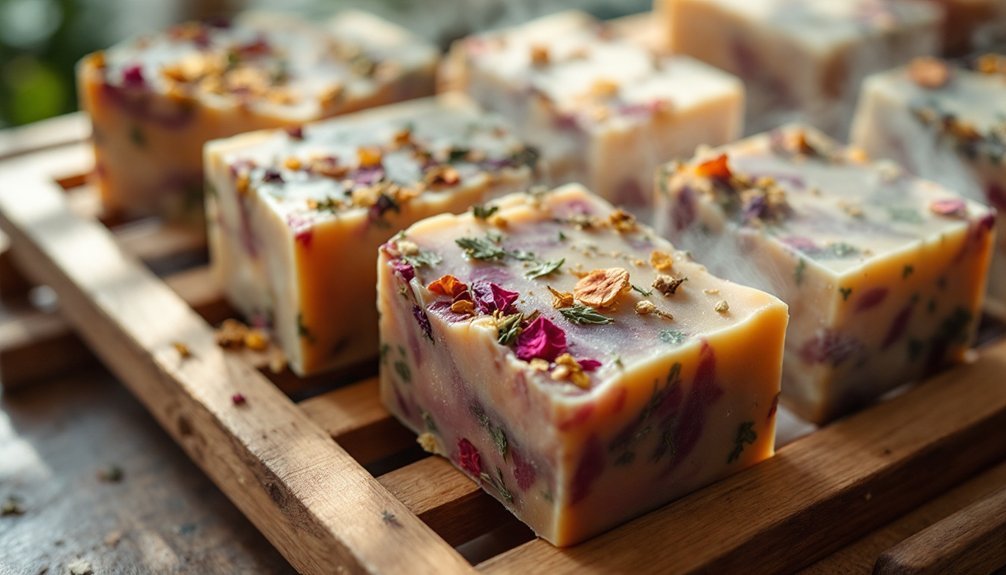



Leave a Reply